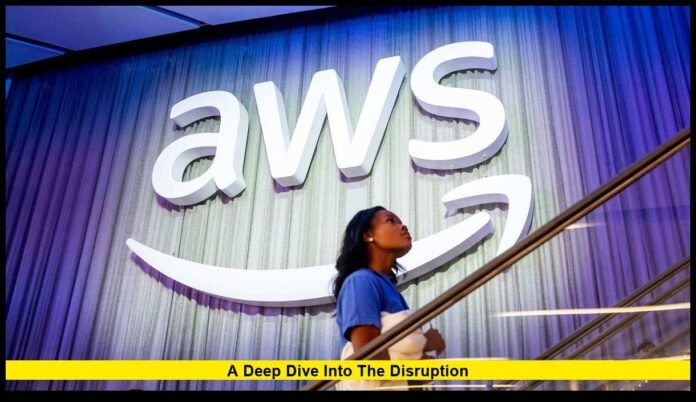The phrase amazon aws outages took center stage on October 20, 2025, when a major disruption in the Amazon AWS cloud-platform knocked out hundreds of applications and websites across the United States and beyond. The incident exposed how heavily many businesses and consumers depend on one cloud provider—and how fragile that dependence can be.
What Triggered the Outage?
The crisis started early in the morning in the US-East-1 region, based in Northern Virginia, when AWS encountered internal failures that prevented certain services from functioning correctly. According to reporting, the root cause was tied to a domain name system (DNS) resolution error compounded by malfunctioning health-monitoring of network load-balancers—key infrastructural elements that route traffic across servers.
Because the region hosts one of the largest concentrations of AWS customers, the problem quickly cascaded. Services that rely on AWS’s infrastructure suddenly failed to locate the correct servers, leading to widespread disruption.
Which Services Went Offline?
The impact of the amazon aws outages was enormous. Many well-known platforms and services were affected, including:
- Social media apps (e.g., Snapchat, Reddit)
- Gaming platforms (e.g., Fortnite, Roblox)
- Payment and fintech apps (e.g., Venmo, Robinhood)
- Smart-home devices and voice assistants (e.g., Amazon Alexa, Ring)
- Corporate and educational systems, countless websites
For many U.S. users, the day started with frozen apps, failed logins, blank home-screens, and smart-home devices that stopped responding. The ripple effect cut across personal life and business infrastructure alike.
Timeline of Events
- Early Hours: Outage begins in US-East-1 with elevated error-rates and failures across many AWS services.
- Morning to Afternoon: Reports flood in of thousands of disruptions globally. Many companies issue status updates that they’re experiencing AWS-dependent issues.
- Evening: AWS announces many systems are returning to normal; full recovery of all affected services follows later.
- Aftermath: Analysts and businesses scramble to assess damage, review redundancy plans and call for cloud-risk strategies.
The Broader Implications for U.S. Business
Single-Point Dependencies
The amazon aws outages shed light on one of the core risks of modern cloud architecture: When many systems depend on one region of one provider, a failure can ripple widely. For U.S. companies that rely on AWS for mission-critical operations, the message is clear—diversification matters.
Operational Cost of Downtime
Even though the outage lasted only hours for many, the financial and reputational cost can be steep: lost transactions, frustrated customers, disrupted workflows, and for some, safety or security-system failures. The incident reminds businesses that resilience is not optional.
National Infrastructure Risk
Because AWS supports not just apps but also parts of critical infrastructure and government services, the amazon aws outages raise questions about resilience at a national level. Can one provider’s slip-up slow down many essential services? The answer appears to be yes.
Pressure on Corporate Strategy
Cloud strategy is evolving. U.S. firms are now asking: Do we have fallback regions? Are we multi-cloud? How quickly can we fail-over? The event adds urgency to these questions.
What Companies Should Do Now
- Adopt Multi-Region Deployments: Distribute critical workloads across multiple geographic zones.
- Consider Multi-Cloud Strategies: Use more than one provider to reduce exposure to one vendor’s outage.
- Test Fail-over Plans Regularly: Simulate outages to validate readiness.
- Monitor Third-Party Dependencies: Know exactly which services rely on your cloud provider’s region.
- Communicate During Outages: The user experience matters—transparency helps maintain trust.
Why This Incident Hit So Hard
- The US-East-1 region is a high-traffic, default-region for many AWS customers—making it a sensitive spot.
- DNS failures are particularly damaging because they disrupt the underlying ability of systems to connect and authenticate.
- A vast global web of services and companies rely on AWS, meaning one regional failure became global in effect.
- The scale of cloud adoption has grown so large that setbacks in one provider ripple into everyday life—from smart homes to financial services.
The Consumer Side: What People Saw
- Smart-home consumers found Alexa and Ring unresponsive.
- Gamers couldn’t log into popular titles like Roblox or Fortnite.
- Payment app users experienced errors or delays sending money.
- Many wondered: “Why is my bank app not working today?” The answer for many was the amazon aws outages.
- Some folks reacted with humor—treating the outages as a forced digital detox—while others voiced real frustration about service interruptions they depend on.
What AWS Says It Will Do
AWS acknowledged the issue and said that engineers were “immediately engaged” to recover services. They confirmed that the underlying DNS and internal service-monitoring issues have been mitigated, though some message-backlogs and latency persisted. The company promised a full incident report to explain the failure, its causes, and steps to avoid a recurrence.
The Lessons Going Forward
For U.S. technology and business leaders, this event was a wake-up call. The amazon aws outages offered tangible proof of how deeply the economy is entwined with cloud infrastructure. The lessons include:
- A single region’s failure can bring down global platforms.
- Infrastructure resilience is now a business continuity issue, not just a tech one.
- The era of “build once, host in one region” is over.
- Transparency and preparedness build trust—even when failures occur.
Final Thoughts
The recent amazon aws outages highlighted vulnerabilities in one of the world’s most powerful cloud platforms—and by extension, vulnerabilities in the businesses, apps and services that rely on it. For U.S. enterprises and digital consumers alike, the message is clear: resilience is no longer optional. Diversification, fail-over planning and cloud governance aren’t just best practices—they’re essentials.
What do you think: Should U.S. businesses spread their cloud across more providers, or is the convenience of “one big platform” still worth the risk? Share your thoughts below and stay tuned as the cloud-industry learns from this event.
